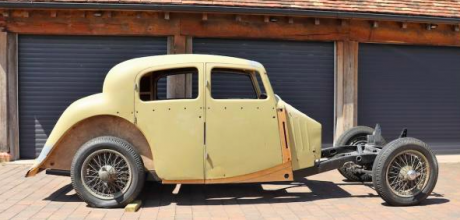The oldest surviving Jaguar - 1936 SS 2.5 Litre Saloon
Even in dirty, pale-yellow primer and shorn of wings, bonnet, grille and glass, you can admire the elegant lines of this sports saloon. The low roofline, the elliptical slot of a rear window and the hint of a gracefully long bonnet implied by the distance between the front door and front axle suggest a car whose lines would have been a cut above those of most cars on the roads back in 1936.
The car in question is an SS Jaguar 2 ½-litre Sports saloon, and it’s claimed to be the oldest surviving Jaguar-labelled model in the UK. Jaguar-labelled, because SS Cars boss (Sir) William Lyons was reluctant to completely abandon the SS name, as recommended by his advertising agency, despite these initials having a fast-rising association with the Nazis. So this part-restored machine, branded SS Jaguar as a compromise, is certainly not the oldest surviving four-wheeled creation of Lyons, but it’s nevertheless of great historical interest and a good-looking car to boot.
THIS EARLY JAGUAR SALOON BEARS ALL THE HALLMARKS OF THAT CUSTOM BODYWORK HISTORY
There’s history in more than the deployment of a name, too, this SS Jaguar was a major step in the company’s evolution towards becoming a full-blooded car maker rather than a mere modifier of other manufacturers’ vehicles. This early Jaguar saloon bears all the hallmarks of that custom bodywork history, however its construction is coach-built rather than the pressed-steel panelwork that was fast becoming popular. Instead, its separate chassis carried a body whose foundation was an ash frame to which steel panels were attached, most of them hand-finished and artfully smeared with lead to hide the joins. Time-consuming, but this method avoided the huge expense of tooling-stamped panels.
Although panel-stamping was where Jaguar was headed, like most of the industry. The SS Jaguar was launched in autumn 1935, but Lyons planned for a pressed-steel bodied update just three years later, this decision partly driven by customer demand that stretched the coach-built approach to the limit; 3,400 cars were made in this way during 1937.
Despite the SS Jaguar’s relative popularity, few survive today, their wood and steel construction succumbing easily to the British weather, some saloons became the basis of the SS 100 sports car evocation, the two models sharing a chassis and much else. Indeed, this particular car was bought for precisely that purpose, until its owner discovered its significance and instead began its restoration, which has progressed a long way. The wooden frame has been reconstructed using seasoned ash, the passenger compartment’s panelling has been reattached and the doors rehung with fresh hinges.
Many of the panels need tweaking, but you can at least see the essence of the car. You can also see the essence of its construction with all the interior trim absent, and the need for woodwork and metalwork skills.
A heap of work ahead, then. More positively, the engine has been rebuilt, the beautiful Lucas P100 headlamps have been restored, together with the starter and dynamo, although the interior consists merely of the seat frames and their runners.
The estimate for this project is £35,000-45,000, and you can probably reckon on spending a good chunk of that again on bodywork, paint, retrimming and reassembly. But at the end, the new owner will not only have a very beautiful mid-Thirties saloon, but also a historically significant Jaguar. Here’s hoping that the job gets finished.


